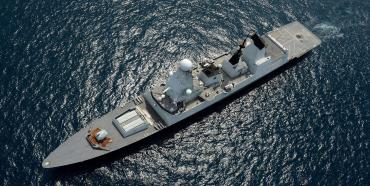January 17, 2022
GE's Power Conversion business supplies high power electrical propulsion system for the latest generation of naval destroyers.
Challenge
Futuristic generation of destroyers
The DDG 1000 Zumwalt-class destroyer is the U.S. Navy's most advanced multi-mission destroyer, and the U.S. Navy’s first full electric propulsion ship.
Balancing proven capability with future-capable technologies, the navy engaged with industry to help meet its demanding needs. Designed for surface warfare, anti-aircraft and naval fire support, the ship's revolutionary technologies extend from its outward appearance to its on-board equipment.

The innovative external appearance is significantly influenced by the wave-piercing tumblehome hull form, the reverse slopes of the smooth deck, the superstructure and guns. This significantly reduces the radar cross-section, returning much less energy than a more hard-angled hull form. The Navy designed the ship in this way because it wanted a stealth platform that could sail at 30 knots, and it required significant electrical power on board to support the all-electric ship and potential power available for future high energy weapons.
Solution
The electric propulsion system is, by some margin, the highest power system of its kind fitted to a vessel of this displacement.
- Integrated electric, high voltage system
- U.S. Navy’s first all-electric ship
- 78.5MW installed electrical power, 2 shafts in advanced electric, scalable architecture, providing power for all loads
- De-risking at Naval Ship Systems Engineering Station (NAVSSES), Philadelphia
- Shock-rated, full naval specification systems
- Advanced Induction Motors
- Tandem motor configuration with three converter channels per motor
- Transformerless VDM25000 PWM converters
- MV switchboards
- Harmonic filters

Proven, Tested Technology
GE's Power Conversion business had proven its Electric Ship capability and expertise with a related Navy technology demonstration program as early as the late 1990s, supplying its Advanced Induction Motor (AIM) and Pulse-Width Modulation (PWM) converter Ship’s Electric Grid technologies for testing at NAVSSES in Philadelphia, PA. In parallel GE had been demonstrating its expertise across other numerous electric and hybrid ship naval and commercial programs.
As the DDG 1000 program evolved, GE Power Conversion supplied its technologies to the Navy’s land-based integrated test facility in Philadelphia, designed for proving high-power naval machines ahead of manufacturing phase.
Following extensive competitive evaluation, GE’s solution was selected to be fitted on the first two ships of the class. In July 2007, Power Conversion finalized details with Northrop Grumman Ship Systems (NGSS) for the DDG1000 High Voltage Single System Vendor (HVSSV). The agreement covered the dual lead ships of the class at NGSS shipyard in Pascagoula, Miss., and at the General Dynamics Bath Iron Works shipyard in Maine.
Benefits
Increased vessel safety and survivability:
- High redundancy at all levels, quiet and shock-capable electrical drive trains.
- Physical separation to suit vessel layout and survivability, connected only by electrical network.
- Enhanced availability, reliability and maintainability: inherently robust power and propulsion plants.
Flexible, frugal and future-proof:
- Lowest number of installed prime movers compared with mechanical or hybrid.
- Energy-efficiency across different duty cycles.
- Easily adaptable to changing mission profiles, and future integration of low/zero emission power sources.
- Total cost of ownership savings in fuel and maintenance, due to running optimum number of prime movers at optimum loadings to match power demand.
- Large amounts of installed electrical power can accommodate significant future increases in combat system loads, such as weapons and radar, with minimal impact.



